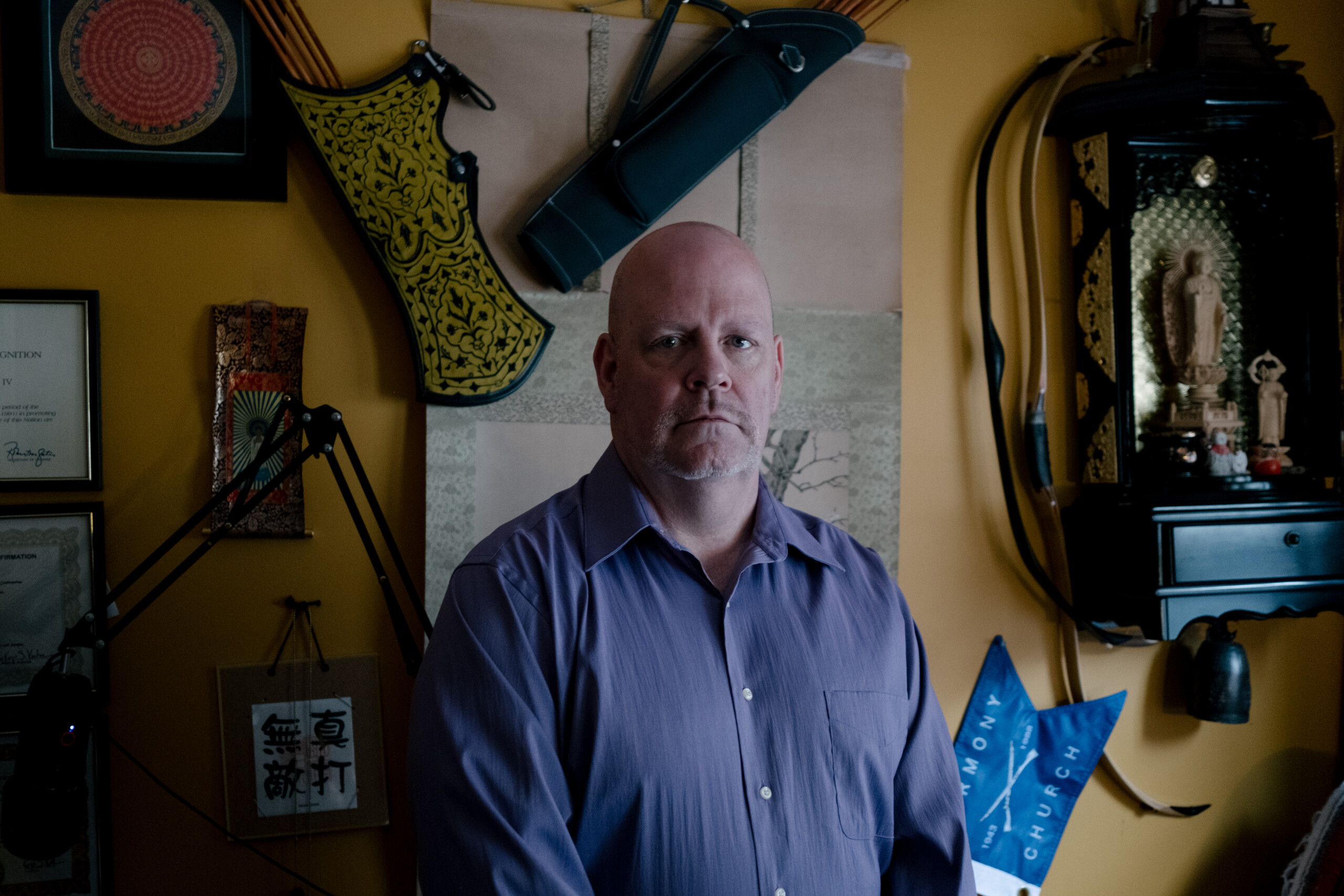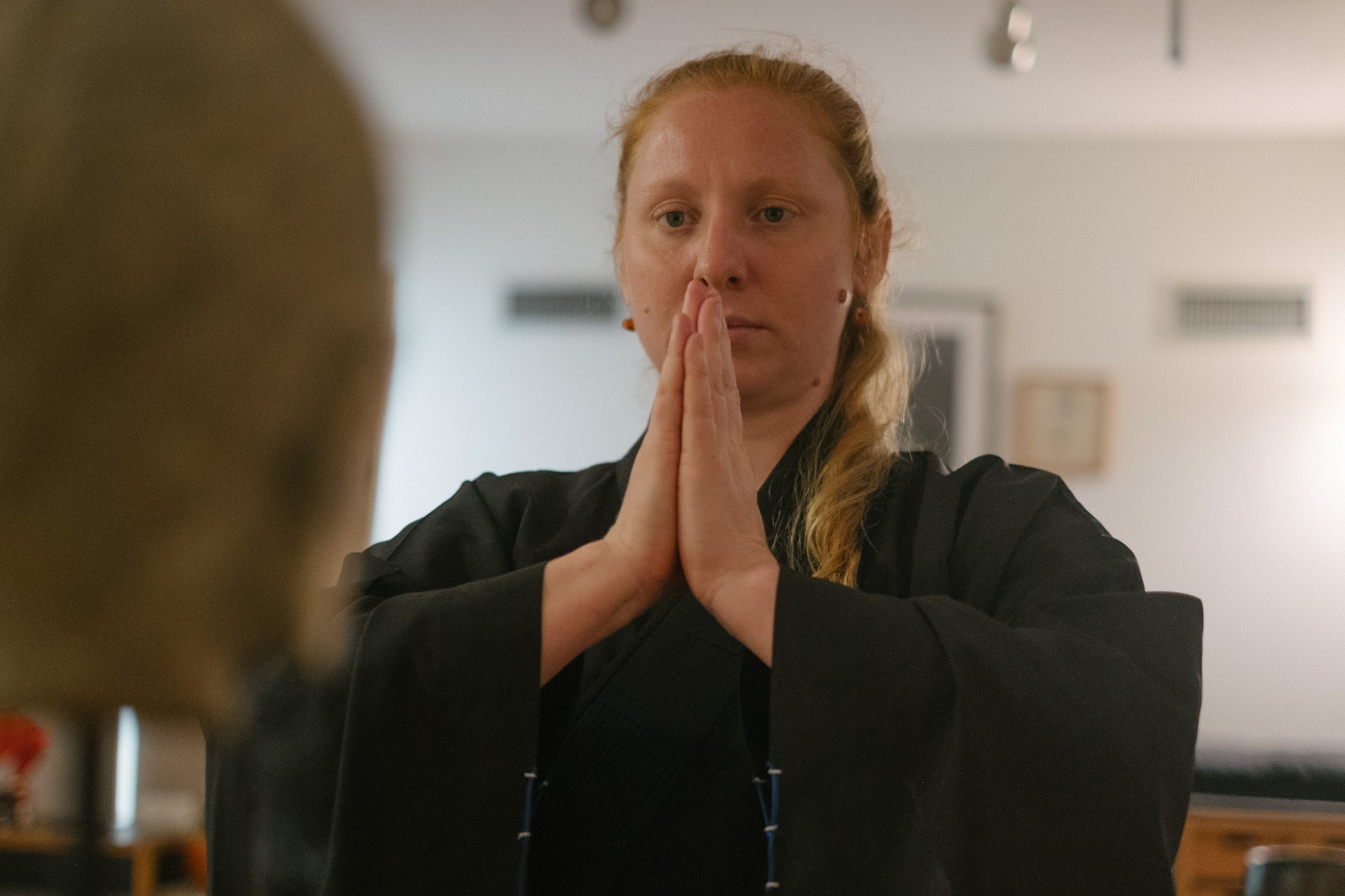Background
William, a combat veteran with a diverse background, is deeply connected to his roots despite being far from them. Born in Charleston, South Carolina, to a Protestant minister grandfather and a missionary grandmother, he was exposed to various cultures during his travels with his grandmother to places like Central and South America, Pakistan, and more.
His journey into Buddhism began while traveling with his grandmother as a missionary. Despite initially considering following in his grandfather’s religious footsteps, William found himself drawn to Buddhism. This interest deepened during his time in the military, where he sought solace in Buddhism’s teachings while enduring challenging training.
After leaving the military, William faced physical and mental challenges due to combat injuries, including a traumatic brain injury. His life took a positive turn when he met his wife, Renee, who encouraged him to seek medical help. This led him to the Veterans Administration at Jesse Brown VA Hospital in Chicago, where he now serves as the Buddhist chaplain.
William’s commitment to helping veterans extends beyond his role as a chaplain. He runs a nonprofit for veterans, assisting them with PTSD and navigating the complexities of the veterans’ system. His work is inspired by his grandmother’s compassionate efforts, which included delivering medicine and building homes for those in need.
Despite his physical challenges, William remains dedicated to his mission. He emphasizes inclusivity and interfaith cooperation, drawing on his diverse experiences with different cultures and religions. He has explored various traditions, including martial arts and Zen Buddhism, shaping his unique perspective on spirituality.
Throughout his journey, William has met influential figures like Reverend Campbell and Dr. Buncha, who have contributed to his understanding of Buddhism. Despite exploring different traditions, William remains true to his compassionate and inclusive approach, carrying on the legacy of his grandmother’s work.
In summary, William’s life is a tapestry woven with threads of diverse experiences, marked by his dedication to helping others, particularly veterans, and his exploration of spirituality across different traditions.
Meditation
William reflects on the limitations and potential pitfalls of meditation, noting that it may not work for everyone and can even increase anxiety or depression in some cases. He critiques the abundance of meditation apps and the commercialization of mindfulness, emphasizing the importance of incorporating the Dharma, or Buddhist teachings, into meditation practices.
For William, meditation is a tool within his broader practice, including haiku, martial arts, and Buddhism. He shares his belief in the value of selfless acts, emphasizing the importance of being aware without seeking personal recognition. His teachings include concepts of compassion, gratitude, and the joy derived from giving and receiving.
William’s journey in understanding meditation involves an eclectic mix of influences, blending elements from various traditions, including Irish-American, Japanese Buddhism, and Shinran Shonin’s teachings. He expresses concern about the potential commodification of American Buddhism, criticizing a lack of genuine giving and questioning the motives behind certain mindfulness apps.
In his evolving spiritual path, William values the sense of community and mutual support, rejecting the notion of pulling oneself up by their own bootstraps. He finds joy in acknowledging the interdependence of individuals and the need for gratitude and willingness to accept help. Embracing a middle path, he highlights the importance of moderation in lifestyle choices and emphasizes the joy derived from understanding and living by these principles.
Relationships
William reflects on his late wife’s spiritual journey, describing her upbringing in the Catholic tradition and her early achievements as a concert pianist. Despite her dedication to Catholicism, she faced challenges and questions, especially after her divorce and excommunication from the church. William noticed her searching for something more, delving into topics like quantum mechanics.
Over the course of their relationship, spanning 21 years, William observed her evolving views. She explored Buddhism, influenced by William’s own Buddhist path and experiences with monks. Eventually, she took her vows and adopted the Buddhist name Joe, embodying all-encompassing compassion. This transition occurred about six months before her passing.
William emphasizes the significance of her Buddhist practice in coping with illness and facing the impermanence of life. He recounts moments of acceptance and how her evolving understanding of Buddhism helped her find peace. Even in the face of illness, she remained committed to her pursuits, organizing a Zoom class the day before her passing.
As William shares the details of her final moments, he expresses a mix of grief and joy. He highlights the impact of her teachings and the sense of community support, drawing parallels between Buddhist concepts and the interconnectedness of life. William appreciates the role of Sangha, the community, in providing comfort during difficult times.
The narrative extends to their daughter, who embraced Buddhism in her own way. William stresses the importance of leading by example and living the Dharma rather than merely preaching it. He details their daughter’s multicultural upbringing, acceptance of diversity, and her reliance on Buddhist principles in coping with her mother’s passing.
In closing, William reflects on the strength and acceptance demonstrated by both his late wife and their daughter in the face of impermanence. He expresses gratitude for the support from various traditions and communities during this challenging time, highlighting the enduring impact of living a life aligned with Buddhist principles.
Teachings
William clarifies the essence of Buddhist practices, emphasizing that offerings and bows are not supplications or requests for favors, as Buddhism doesn’t involve praying to a deity. He draws parallels between bowing to a teacher and the act of offering incense to images of revered figures in Buddhism, highlighting that these gestures are expressions of honor and gratitude rather than worship.
He dispels the misconception that Buddhism is solely about suffering, asserting that suffering is a loaded term and explaining it in the context of impermanence. William shares personal experiences, such as the passing of his wife, to illustrate that suffering arises from attachment to how things were rather than accepting their impermanence.
William reflects on the Buddhist concept of the Eightfold Path, emphasizing that it isn’t a linear journey but can take various forms. He elaborates on the impermanence of all things, from new cars to relationships, illustrating that accepting change leads to a deeper understanding of joy and gratitude.
Discussing the term “enlightenment,” William clarifies that it doesn’t necessarily involve transcending the world but can be experienced in moments of awakened awareness. He acknowledges the fluctuations between being somewhat awakened and fully attached, emphasizing the importance of accepting the causes and conditions of life.
In conclusion, William encourages a nuanced understanding of Buddhist principles, underscoring the significance of compassion, gratitude, and joy in navigating life’s impermanence. He demonstrates a practical approach to embracing the present moment and finding enlightenment amid life’s challenges.
Teachings
William clarifies the essence of Buddhist practices, emphasizing that offerings and bows are not supplications or requests for favors, as Buddhism doesn’t involve praying to a deity. He draws parallels between bowing to a teacher and the act of offering incense to images of revered figures in Buddhism, highlighting that these gestures are expressions of honor and gratitude rather than worship.
He dispels the misconception that Buddhism is solely about suffering, asserting that suffering is a loaded term and explaining it in the context of impermanence. William shares personal experiences, such as the passing of his wife, to illustrate that suffering arises from attachment to how things were rather than accepting their impermanence.
William reflects on the Buddhist concept of the Eightfold Path, emphasizing that it isn’t a linear journey but can take various forms. He elaborates on the impermanence of all things, from new cars to relationships, illustrating that accepting change leads to a deeper understanding of joy and gratitude.
Discussing the term “enlightenment,” William clarifies that it doesn’t necessarily involve transcending the world but can be experienced in moments of awakened awareness. He acknowledges the fluctuations between being somewhat awakened and fully attached, emphasizing the importance of accepting the causes and conditions of life.
In conclusion, William encourages a nuanced understanding of Buddhist principles, underscoring the significance of compassion, gratitude, and joy in navigating life’s impermanence. He demonstrates a practical approach to embracing the present moment and finding enlightenment amid life’s challenges.
Lineage
In William’s narrative, he discusses his connection to the Generations Who tradition, particularly the Buddhist temples in Chicago and other locations. He highlights the welcoming nature of these temples, contrasting them with traditional practices that involve removing shoes and sitting on the floor. William appreciates the sense of community, devotion, and the format of service, making it relatable to Westerners.
He delves into the concept of the Eightfold Path, emphasizing the importance of working towards the well-being of all beings and the idea of leaving no one behind. William interprets the Pure Land as an enlightened state accessible in the present moment rather than a distant or post-mortem reality.
The narrative touches on the balance between self-power and other-power, with a focus on being of service to others. William shares the story of Jodo Shinshu founder Shinran, highlighting the flexibility of the path, whether on a mountain or as a householder.
The importance of giving, both in terms of material assistance and time, is a key theme. William reflects on the support he received after his wife’s passing and emphasizes the practice of generosity in daily life.
The narrative concludes with a reference to the philosophy of “Just be excellent to each other,” drawing a parallel with the Buddhist principles of Sangha and Dharma. William suggests that the essence of Buddhism, as he understands it, lies in being compassionate, understanding, and supportive towards others, regardless of individual paths or traditions.















































































